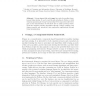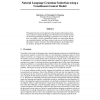120 search results - page 8 / 24 » How Much Can We Gain from Supervised Word Alignment |
ACL
1992
13 years 11 months ago
1992
We have recently reported on two new word-sense disambiguation systems, one trained on bilingual material (the Canadian Hansards) and the other trained on monolingual material (Ro...
IEEEMSP
2002
IEEE
14 years 3 months ago
2002
IEEE
Music query-by-humming is a challenging problem since the humming query inevitably contains much variation and inaccuracy. Many of the previous methods, which adopt note segmentat...
WWW
2011
ACM
13 years 5 months ago
2011
ACM
This paper uses the URL word breaking task as an example to elaborate what we identify as crucialin designingstatistical natural language processing (NLP) algorithmsfor Web scale ...
PKDD
2004
Springer
14 years 3 months ago
2004
Springer
Abstract. Orange (www.ailab.si/orange) is a suite for machine learning and data mining. It can be used though scripting in Python or with visual programming in Orange Canvas using ...
NIPS
2001
13 years 11 months ago
2001
This paper presents a novel approach to the unsupervised learning of syntactic analyses of natural language text. Most previous work has focused on maximizing likelihood according...


